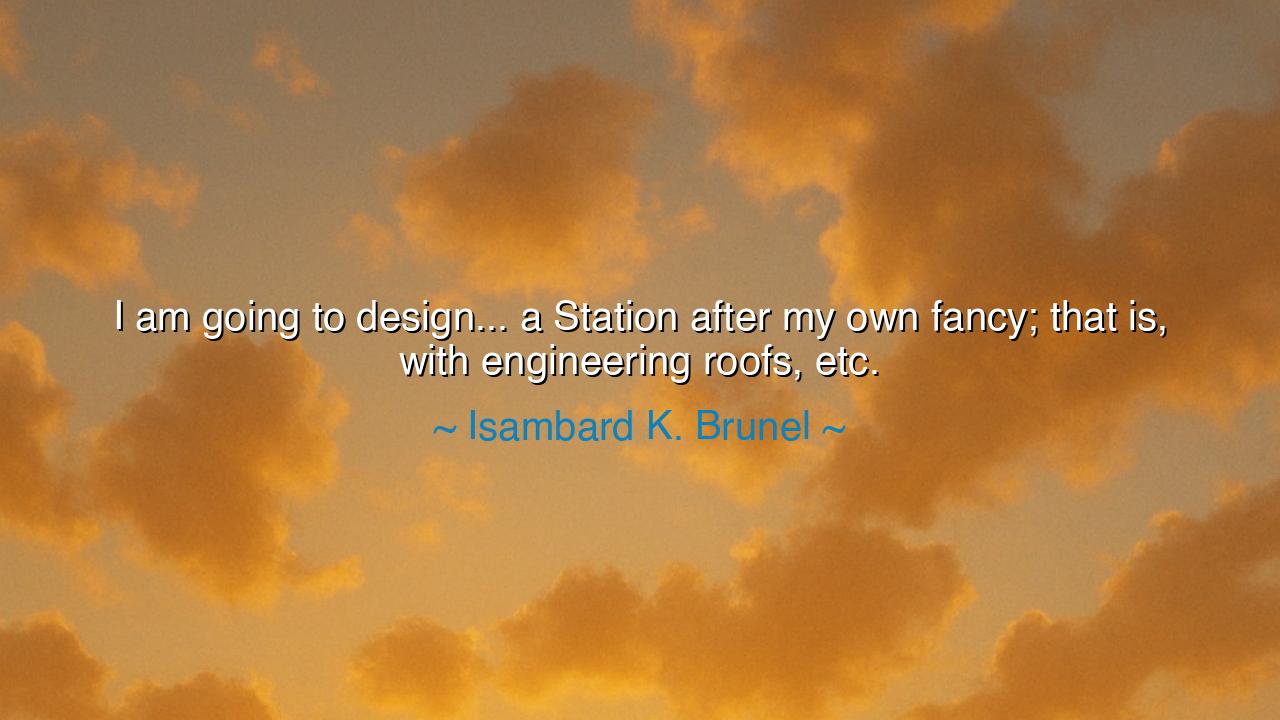
I am going to design... a Station after my own fancy; that is
I am going to design... a Station after my own fancy; that is, with engineering roofs, etc.






“I am going to design… a Station after my own fancy; that is, with engineering roofs, etc.” — Isambard Kingdom Brunel
Listen, O builders and dreamers, to the voice of Isambard Kingdom Brunel, the titan of the Industrial Age, whose iron roads stitched together a new world. In this declaration, spoken in the vigor of his genius, he reveals the spirit of a creator unafraid to shape reality according to his vision. When Brunel said, “I am going to design a Station after my own fancy,” he was not merely planning a structure of stone and steel — he was proclaiming a philosophy: that the architect of progress must dare to imagine beyond convention. His “engineering roofs” were not just shelter for travelers, but symbols of innovation, a union of art and science beneath the same sky.
The origin of these words lies in Brunel’s work upon the Great Western Railway, one of the most ambitious enterprises of the nineteenth century. At its heart would stand Paddington Station, the grand terminus that he envisioned as both functional and majestic — a cathedral of modernity. Where others saw only necessity, Brunel saw beauty; where others were content with efficiency, he sought grandeur. His “engineering roofs,” vast and graceful arcs of glass and iron, were unlike anything seen before, allowing sunlight to pour into the heart of the building as though the heavens themselves blessed the journey of man. Thus his words were not a boast, but a vow — a declaration that utility and elegance could, and must, coexist.
In his age, the world trembled on the edge of transformation. Steam and steel had given man dominion over land and sea, but it was men like Brunel who gave these forces form and soul. To design “after his own fancy” was not to indulge vanity, but to trust the guiding instinct of genius — that quiet voice within every true creator that whispers, “Do not imitate. Build anew.” Brunel’s life was a hymn to this principle. His bridges soared across rivers as if defying gravity itself; his ships, the Great Eastern and Great Britain, stretched the limits of imagination and engineering. His work was not mere construction — it was vision made tangible, thought forged in iron.
Yet his statement carries a wisdom deeper than the pride of achievement. It teaches that creation must be personal — that one must shape one’s work not to please the crowd, but to fulfill the truth within one’s own mind. Brunel’s “own fancy” was not whimsical; it was the disciplined dream of a man who knew both the laws of physics and the poetry of ambition. Too often, the world demands conformity, bidding us build according to precedent, safe within the shadows of what has been done. But Brunel’s life reminds us that the future is not born of imitation — it is born of courage, the courage to follow one’s inner compass even when it points into uncharted lands.
Consider the legacy of Antoni Gaudí, centuries later, who, like Brunel, built “after his own fancy.” In Barcelona, Gaudí shaped the Sagrada Família not by the measures of classical architecture, but by the rhythms of nature — curves inspired by bones, towers by trees, windows by light itself. He too was mocked in his time, yet his vision endures, as Brunel’s does, because both men listened to the same ancient law: that the creator must obey his own genius, for genius is the language of the divine made human. Brunel’s station and Gaudí’s basilica are separated by craft, but united by soul — each a monument to imagination’s defiance of mediocrity.
What, then, shall we learn from Brunel’s words? That each of us, in our work, must find the balance between reason and imagination. Build, yes, with logic, with skill, with discipline — but also with heart. Let no design, no dream, no plan be only what others expect. Let it be yours, stamped with your conviction, your daring, your originality. For the world remembers not the obedient builder, but the bold one who saw in iron and stone the promise of eternity. Brunel’s “engineering roofs” still arch over Paddington, still gleam beneath the daylight — proof that what is built in truth and vision does not age, but lives on.
So, O creators of tomorrow, take this lesson as sacred: Design after your own fancy. Not in arrogance, but in authenticity. Let your craft reflect your soul as Brunel’s station reflected his — strong, purposeful, and filled with light. Do not fear the mockery of the cautious nor the doubt of the timid. For the mark of greatness is not in pleasing the many, but in creating what only you could create. The roofs of your life — whether of iron, word, or dream — must be built with the strength of knowledge and the spirit of wonder. Then, like Brunel’s station, they shall stand long after you are gone, radiant with the power of imagination made real.






AAdministratorAdministrator
Welcome, honored guests. Please leave a comment, we will respond soon